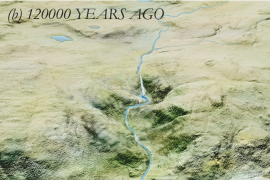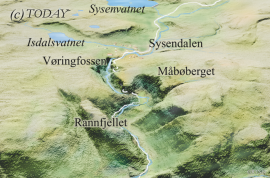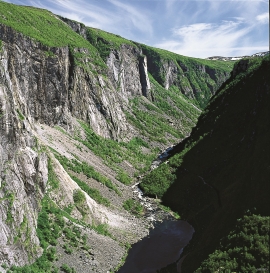Published: 06.09.2015 | Author: Inge Aarseth
Vøringsfossen waterfall and the Upper Måbødalen Valley, as seen from the viewpoint at Hotel Fossli. The current valley cuts crookedly into an older valley that was there from before. (Helge Sunde)
THE BIG “BACKWARDS-CUT”
The old pack road had 1500 steps, where cars today gas through the mountain. The time of this hard work is over, and of getting used to the steep terrain, as well; only the view from the top is much the same as before. Vøringsfossen in summer is one of Western Norway’s biggest natural wonders. It marks the transition between the older, open part of the Sysendalen valley and the younger, narrow and winding valley of Måbødalen.
Upper Måbødalen valley ends abruptly at the precipice where Vøringsfossen comes thundering off the mountainside. Western Norway has many of these abrupt transitions between a younger narrower valley and an older, wider one. Earlier, Måbødalen Valley ended where the pack road makes its way towards Måbøberget (b in the diagram). Through several ice ages, glaciers and glacial rivers carved the end of the valley back towards the plateau. The younger part of the valley took its own path through the extension - it dug its way crookedly down into the northern side of Sysendalen Valley. The Vøringsfossen waterfall does not flow down the older part of the first valley by the viewpoint, but rather down the side of the end of the valley. But why did the new valley not dig its way along the bottom of the old valley?
A crooked cut into the valley like this one can only happen with the help of the ice during an ice age. Rivers will normally dig their way down the middle of a valley, but rivers with a thick layer of ice above them are able to find another path. The pressure of the ice pushes the water a little ways up from the valley bottom. This is what happened in Måbødalen: the river from the glacier under the ice got pressed out to both sides of the valley and water followed crevices up in the valley sides. The meltwater rivers also dug out canyons and potholes, which there are several of in this area.Not only was the newer valley remarkable in relation to the older Sysendalen, its course also ran crookedly, with east-west and north-south as the predominant directions. Where the directions of the crevices changed, usually at right angles to the first direction, the carving of the ice followed.
Most of the cracks in the mountainside in this area were also vertical. This is how the valley that formed thereafter became very steep - just like Vøringsfossen is today. This is the last stop for the big “backward-cutting” of the ice – at least for now.
The development of the crooked Måbødalen valley, shown in three stages, from before the Ice Age until today. Before the Ice Age, the river passed through a gentle landscape (a), which Sysendalen is the remains of. Måbødalen was carved out through alternating glacial and interglacial periods (b shows the valley as it might have looked like during the last interglacial), and it became a younger valley nested within the older valley. During the last Ice Age the final part of this process was completed, resulting in the landscape we see today (c). (Inge Aarseth/Kjell Helge Sjøstrøm/Masaoki Adachi)
Every time stones slide down into the cone-shaped scree slopes, it is as if a sand grain has landed in a supernatural hourglass. – “The mountainside seems to be sliding away”, as Johannes V. Jensen expressed it after a trip through Måbødalen. The mighty scree slopes that have built up along both sides of the valley bottom are a result of rock falls from the fractured mountainside since the last Ice Age. Through this process, the valley has been growing ever wider. Glaciers from the next ice age will sweep these scree slopes away like sandpaper, as they carve onwards in their path. (Photo: Helge Sunde)







